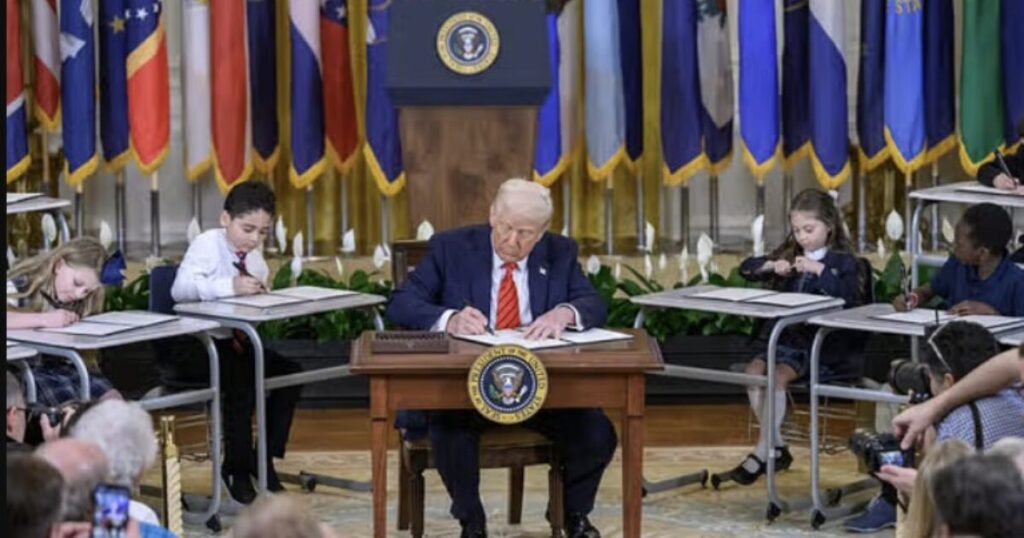“He’s cutting education! Won’t someone please think of the children,” shouted the same people who shut down schools, sports, band, plays, outdoor events, and field trips for two years during COVID. The media and Democrat lawmakers keep claiming that Trump is cutting education—or eliminating it altogether—because, allegedly, Republicans hate education and want an uneducated population that’s easier to control. This, comes from the same Democrats pushing to remove what they call the “reality bias” from science books, claiming it reflects male patriarchy.
The truth is, Trump is not cutting education—he’s cutting bureaucracy and administrative waste. Schools in America are largely funded by state and local governments through property taxes. Unlike many other countries with a national curriculum, U.S. states set their own education standards. In fact, the closest thing to a federal requirement for high school graduation is one unit of physical education. It was recommended by President Kennedy, but never enacted into law. Ironically, gym and sports were the first things shut down during COVID, and they’re often the first programs Democrats want to cut from the curriculum to make room for classes pushing a political or ideological agenda.
That said, if the people want more say over education policy, Trump’s reforms are giving them that opportunity. By cutting down the Department of Education and shifting responsibilities to other agencies or to the states, many of these so-called “cuts” are actually a return of power to state governments and local school boards. In many cases, the dollars are still being allocated to benefit programs. They’re just being administered differently, closer to the communities they serve.
Below is a breakdown of the most significant Trump cuts and the real impacts they may have on students and schools.
In March 2025, President Trump signed an executive order initiating the dismantling of the U.S. Department of Education. While full closure would require congressional approval, the administration has already begun significantly reducing its size. About half of the department’s workforce has been laid off, including key cuts in the Federal Student Aid office and the Office for Civil Rights. These cuts do not directly impact the provision of education to children, which remains largely under the authority of state governments.
At the primary and secondary levels, the administration plans to reallocate many education-related responsibilities. The National School Lunch Program (NSLP), which Democrats and the media wrongly accused Trump of terminating, will continue to be administered by the USDA—just as it always has been. Student loan servicing may be transferred to the Small Business Administration, while nutrition and special needs programs could move to the Department of Health and Human Services. These benefits will continue to exist but will be administered differently, with the goal of reducing costs.
Funding for special education is primarily governed by the Individuals with Disabilities Education Act (IDEA) and is largely provided by state and local governments. While the Trump administration has proposed consolidating certain federal education grants, there is no indication that IDEA funding has been eliminated.
Department of Agriculture (USDA). A major feature of the administration’s 2025 budget is the consolidation of 18 separate K–12 grant programs into a single Elementary and Secondary Education Flexible Block Grant. The stated goal is to reduce bureaucratic overhead and allow states more flexibility in allocating federal education dollars.
However, the total amount allocated for the new block grant is approximately $4.7 billion, about $4 billion less than the combined budgets of the original programs. These include funding for teacher training, afterschool programs, school safety, mental health services, and academic enrichment.
Just because federal funding for things like teacher training, afterschool care, or school mental health is being cut doesn’t mean those programs will disappear. It just means states and local districts will decide for themselves which ones they want to keep and whether to make up any funding shortfall. In reality, most districts never used all of these programs anyway, so a lot of the federal money was being directed toward services many schools didn’t want or need.
The Trump administration’s 2026 budget proposes eliminating all funding for the TRIO programs, which support low-income, first-generation college students, veterans, adult learners, and students with disabilities. Services include academic tutoring, mentoring, financial counseling, and other forms of assistance aimed at college access and completion.
They claim that eliminating TRIO would remove these critical support structures, potentially hindering the ability of disadvantaged students to enter and succeed in higher education. However, cutting TRIO does not mean cutting all services for those groups. Trump only cut one specific program. Students with disabilities will still be eligible for support from IDEA, ADA/Section 504, and campus Disability Support Services. Veterans will still have access to the Post-9/11 GI Bill, VA Education and Training Services, and on-campus Veteran Resource Centers. First-generation and low-income students can still benefit from Pell Grants, FSEOG, and institutional support programs run by colleges and universities.
Additionally, the budget includes significant cuts to the Federal Work-Study (FWS) program, which provides part-time jobs for students with financial need. The administration suggests that universities should fund these jobs themselves, effectively shifting the financial burden away from the federal government.
Pell Grants are federally mandated and continue to be available to eligible students. However, the program faces a projected $2.7 billion funding deficit by 2026, which could lead to future reductions if not addressed by Congress. For the 2025–26 academic year, grants remain unaffected.
It is a myth that the Trump administration is eliminating education or reducing the quality of educational delivery or outcomes. Some changes are aimed at cutting bureaucracy or restructuring how programs are administered, while others have been eliminated entirely because they had little or nothing to do with improving educational outcomes.
Read the full article here


